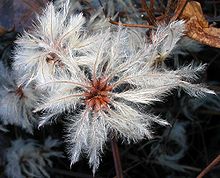| Clematis vitalba | |
|---|---|

| |
| The silky appendages of the fruits | |
| Scientific classification | |
| Kingdom: | Plantae |
| Clade: | Tracheophytes |
| Clade: | Angiosperms |
| Clade: | Eudicots |
| Order: | Ranunculales |
| Family: | Ranunculaceae |
| Genus: | Clematis |
| Species: | C. vitalba
|
| Binomial name | |
| Clematis vitalba | |


Clematis vitalba (also known as old man's beard[1] and traveller's joy) is a shrub of the family Ranunculaceae.
Description
[edit]Clematis vitalba is a climbing shrub with branched, grooved stems, deciduous leaves, and scented greeny-white flowers with fluffy underlying sepals. The many fruits formed in each inflorescence have long silky appendages which, seen together, give the characteristic appearance of old man's beard. The grooves along the stems of C. vitalba can easily be felt when handling the plant.
This species is eaten by the larvae of a wide range of moths. This includes many species which are reliant on it as their sole foodplant; including small emerald, small waved umber and Haworth's pug.
Range
[edit]C. vitalba has a preference for base rich alkaline soils and moist climate with warm summers.[citation needed] The species is native to Eurasia and North Africa.[2]
United Kingdom
[edit]In the UK it is a native plant and is common throughout England south of a line from the River Mersey and the River Humber. It also commonly occurs in southern, Eastern and northern Wales. Outside of these areas it is widely planted and occurs as far north as the southern highlands of Scotland.[3]
As an invasive species
[edit]Due to its disseminatory reproductive system, vitality, and climbing behavior, Clematis vitalba is an invasive plant in many places.[4][5] The species is capable of rapid growth, climbing several times faster than English ivy, and each plant may produce in excess of 100,000 seeds. The plant may also spread through stem and root fragmentation.[6]
New Zealand
[edit]In New Zealand it is declared an "unwanted organism" and is listed in the National Pest Plant Accord. It cannot be sold, propagated or distributed. It is a potential threat to native plants since it grows vigorously and forms a canopy which smothers all other plants and has no natural controlling organisms in New Zealand. New Zealand native species of Clematis have smooth stems and can easily be differentiated from C. vitalba by touch.[citation needed]
North America
[edit]In North America, old man's beard is considered an invasive species. It is found in Washington, Oregon, California, and British Columbia. The species is also found in the eastern United States.[2] The species was introduced as an ornamental plant in the Pacific Northwest sometime between 1950 and 1970.[6]
Characteristics
[edit]- Reproductive organs:
- Inflorescence type: biparous cyme
- Sex: hermaphrodite
- Type of pollination: entomophilous
- Seed:
- Type of fruit: achene
- Dissemination: With the wind
- Habitat and distribution:
- Type of habitat: Mid-European shrubberies, mountainsides, in moderately eutrophic regions
- Distribution: Holarctic
C. vitalba grows well in limey soils.[1]
Diseases
[edit]C. vitalba suffers from tomato spotted wilt virus.[7]
Use
[edit]Clematis vitalba was used to make rope during the Stone Age in Switzerland.[8] In Slovenia, the stems of the plant were used for weaving baskets for onions and also for binding crops.[9] It was particularly useful for binding sheaves of grain because mice do not gnaw on it.[10] In Italy, the sprouts are harvested to make omelettes (called "vitalbini" in Tuscany, "visoni" in Veneto).
Gallery
[edit]-
Flowers
-
Close-up of a flower
-
Leaves
-
Fruits
References
[edit]- ^ a b Brian Proudley; Valerie Proudley (1989). Heathers in Colour (2nd ed.). Blandford Press. p. 37. ISBN 0713714204.
The sort of plants already growing on the site will give a clue as to the nature of the soil. ... The presence of Old Man's Beard (Clematis vitalba), Beech (Fagus sylvatica) and Yew (Taxus baccata) are likely to mean that lime is present.
- ^ a b "Clematis vitalba". biology.burke.washington.edu. Retrieved 10 October 2022.
- ^ New Atlas of the British and Irish Flora
- ^ "Clematis vitalba Profile – California Invasive Plant Council". Retrieved 2024-01-22.
- ^ Invasive Species Compendium. "Clematis vitalba". Archived from the original on 2012-04-01. Retrieved 2017-05-24.
- ^ a b "Old Man's Beard (Clematis vitalba)". portland.gov. Portland Bureau of Environmental Services. Retrieved 10 October 2022.
- ^ "Tomato spotted wilt virus (TSWV00)[Overview]". Global Database. EPPO (European and Mediterranean Plant Protection Organization). 2002-11-26. Retrieved 2022-05-05.
- ^ Johnson, Magnus. 2001. The genus Clematis. Södertälje: Magnus Johnsons Plantskola AB, p. 37.
- ^ Petauer, Tomaž. 1993. Leksikon rastlinskih bogastev. Ljubljana: Tehniška založba Slovenije, p. 139.
- ^ Kržan, Vanja. 2010. "Mi pa oznanjamo Kristusa, križanega (1 Kor 1,23)." Zaveza 42 (25 February). Archived 2012-06-29 at the Wayback Machine (in Slovene)
External links
[edit]- Global Invasive Species Database Archived 2012-03-19 at the Wayback Machine - Clematis vitalba
- Traveller's joy at Bioimages.org
- Traveller's joy by Regional Burgas Museum Clematis vitalba in Bulgaria



